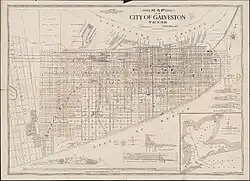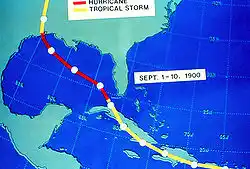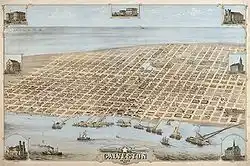
The 1900 Galveston hurricane was a hurricane which struck the city of Galveston in the southeast of the state of Texas in the United States on the 8th of September 1900. The hurricane formed in late August and moved through the Caribbean before hitting Galveston as a Category 4 hurricane with wind speeds of 140 miles per hour. It destroyed most of Galveston and somewhere between 6,000 and 12,000 people were killed, the most likely figure being in the vicinity of 8,000 people. Over a billion dollars’ worth of damage in modern monetary terms was inflicted. The storm is often referred to as the Great Galveston Hurricane and is one of the deadliest hurricane events in modern recorded history. It remains the deadliest natural disaster in the history of the United States. The hurricane had considerable implications for migratory patterns in this part of Texas in the early twentieth century. It slowed the growth of Galveston as a town and the use of the city as an entry point into the country, as up until then Galveston had been emerging as a major migration port in the Gulf of Mexico.[1]
Research your ancestors on MyHeritage
1900 Galveston hurricane chronology of events1900 Galveston hurricane chronology of events

The 1900 Galveston hurricane occurred at a time when meteorological data was not very accurate or even possible to collect in some respects. As such, we know less about it than we do modern destructive storms like Hurricane Katrina that struck New Orleans in 2005. What we do know is that the storm developed in the Caribbean around the 27th of August 1900 and then moved westwards into the Gulf of Mexico in early September. It increased in intensity in the days that followed and then made landfall over Texas as a Category 4 hurricane on the 8th of September 1900. Galveston bore the brunt of the storm, being battered by winds reaching 140 miles per hour. After battering the town and moving inland the storm weakened and dissipated in the course of the 9th, 10th and 11th of September.[2]
The clean-up was a grim prospect. Bridges and telegraph lines had been destroyed and Galveston, much of which lies on an island, was virtually cut off from the outside world. It consequently took until the 10th of September before rescuers began entering the town in large numbers. They found it largely destroyed, with over half of the houses devastated and at least 20% of the population dead. To this day demographers dispute the death toll. Some place it as low as 6,000, others as high as 12,000, but the broader consensus is that the figure lies closer to 8,000. Over 10,000 people were also left homeless. Food shortages, disease outbreaks and other problems followed and it would be many months before Galveston began to recover.[3]
Extent of migration to Galveston before the hurricaneExtent of migration to Galveston before the hurricane

The hurricane struck Galveston during a period in which the city had become a boomtown of the southern United States. The country had experienced one of the largest mass migrations in history during the nineteenth century, as tens of millions of people migrated from Europe to the Americas. Twelve million arrived to the US alone between 1870 and 1900.[4] Though a huge proportion were arriving to the Castle Garden migration center in New York City and its successor, Ellis Island, there were other entry points in places like Boston and San Francisco. One such on the coast of the Gulf of Mexico was the port of Galveston. In the second half of the nineteenth century it became the main entry port into Texas at a time many people were sailing to here and then trekking westwards to places like California as the American West opened up to settlement.[5]
Inevitably Galveston grew as a major port itself and the late nineteenth century is usually referred to as the 'Golden Age of Galveston'. During this time the population grew from just around 4,000 people in 1850 to 20,000 in the late 1870s and was nearing 40,000 people when the hurricane hit in 1900. It had grown from 29,000 to about 38,000 people alone in the course of the 1890s. Thus, Galveston was both a booming town itself in the decades prior to the hurricane and was also acting as a major conduit for migration into Texas and the American West.[6] This included a very substantial community of Jewish people from places like Germany and the Polish lands of the Russian Empire.[7]
Demographic impact of the 1900 Galveston hurricaneDemographic impact of the 1900 Galveston hurricane
The demographic impact of the hurricane was very considerable. Much of the city was destroyed and somewhere between 20% and 25% of the population were killed. Unlike cities like Chicago, which counter-intuitively experienced a fresh population boom in the 1870s after the 1871 Chicago Great Fire, Galveston went into decline after the hurricane and its golden age came to an end. It took until 1911 for the population to return to its pre-hurricane level and even then it grew slowly, only reaching a population of 50,000 people in the late 1920s. Galveston has never grown significantly beyond this level since.[8]

That Galveston did not grow into a major Texan city in the twentieth century was because the maritime traffic that had been flowing to it in the nineteenth century went elsewhere in the early twentieth century. The port of Houston superseded Galveston in the 1900s and that city was the major demographic beneficiary of the hurricane. The population of Houston was around 45,000 people when the hurricane struck in 1900. It doubled to 90,000 by the early 1910s and reached quarter of a million people in the mid-1920s. By the early 1960s Houston had expanded to become a city of one million inhabitants. Approximately 2.3 million people live there today and its port is one of the busiest in the world.[9]
This was a knock-on effect of the Galveston hurricane of 1900 to a significant extent. Thus, many tens of thousands of people living in Houston today will have an ancestor who settled here in the early twentieth century simply because the port of Galveston had been superseded by Houston in the aftermath of the hurricane. Hundreds of thousands, or even millions of Americans will have an ancestor who passed through Houston in the 1900s, 1910s and 1920s, where they might have gone through Galveston on arrival to the US had it not been for the hurricane.[10]
Research Texas ancestors on MyHeritageResearch Texas ancestors on MyHeritage
Research your ancestors on MyHeritage
Explore more about the 1900 Galveston hurricaneExplore more about the 1900 Galveston hurricane
- Galveston Daily News, Texas, Index of Death Notices, 1865-1977 records collection on MyHeritage
- Galveston, Texas, City Directory, 1906 records collection on MyHeritage
- Texas, County Births records collection on MyHeritage
- Texas Marriages and Divorces records collection on MyHeritage
- Texas Deaths records collection on MyHeritage
- Texas, Newspapers, 1848-2009 records collection on MyHeritage
- Texas, County Tax Rolls, 1846-1910 records collection on MyHeritage
- Fundamentals of Researching Texas at Legacy Family Tree Webinars
- Texas Genealogy: Online Research in the Lone Star State at Legacy Family Tree Webinars
- Texas Vital Records and their Substitutes at Legacy Family Tree Webinars
References
- ↑ John Edward Weems, ‘The Galveston Storm of 1900’, in The Southwestern Historical Quarterly, Vol. 61, No. 4 (April, 1958), pp. 494–507.
- ↑ https://www.galvestonhistory.org/news/the-1900-storm
- ↑ https://guides.loc.gov/chronicling-america-galveston-flood
- ↑ https://www.loc.gov/classroom-materials/united-states-history-primary-source-timeline/rise-of-industrial-america-1876-1900/immigration-to-united-states-1851-1900/
- ↑ https://www.researchgate.net/figure/Population-Growth-in-Galveston-Following-the-Hurricane_fig19_5187487
- ↑ Susan Wiley Hardwick, Mythic Galveston: Reinventing America’s Third Coast (Baltimore, 2002).
- ↑ https://www.isjl.org/texas-galveston-encyclopedia.html
- ↑ https://worldpopulationreview.com/us-cities/texas/galveston
- ↑ https://worldpopulationreview.com/us-cities/texas/houston
- ↑ https://journals.sagepub.com/doi/abs/10.1177/0096144204274394

